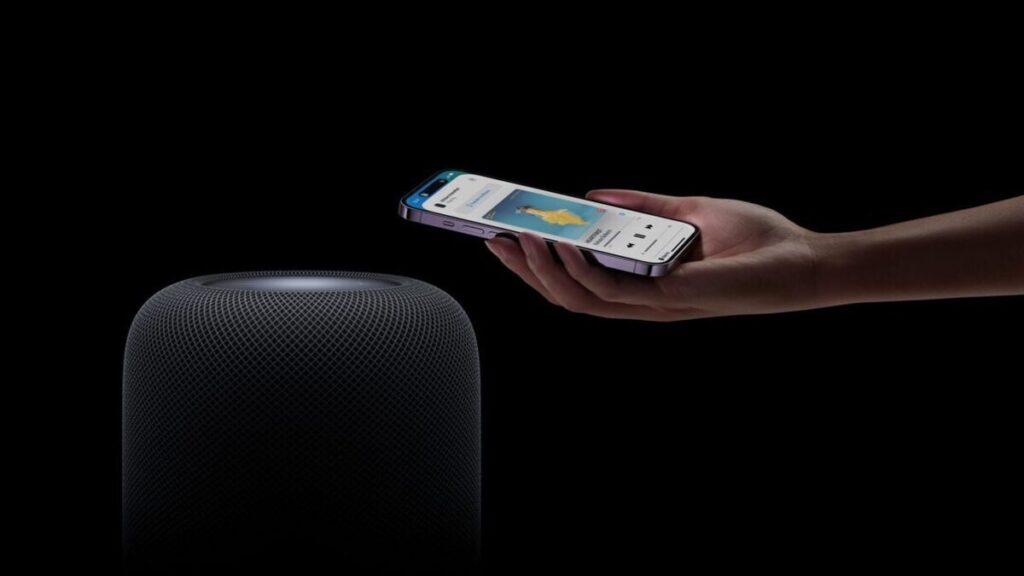To reset a HomePod, you can follow these steps:
- Unplug the HomePod: Disconnect the HomePod from the power source by unplugging it.
- Wait for a Few Seconds: Allow the HomePod to remain unplugged for about 10 seconds.
- Plug It Back In: Reconnect the HomePod to the power source by plugging it back in.
- Wait for the Reset Sound: After plugging in the HomePod, you will hear a distinctive reset sound, indicating that the HomePod has been reset.
- Reset Completed: The HomePod has now been reset to its default settings.
Please note that this reset process erases any personalization or settings on the HomePod. If you’re experiencing issues with your HomePod and are attempting to reset it, this process should help resolve some common problems.
Apple has introduced its latest smart speaker, the (2nd generation), which boasts exceptional audio quality, enhanced Siri capabilities, and advanced smart home features. This innovative device provides an immersive listening experience with its computational audio and support for Spatial Audio. It enables hands-free management of everyday tasks, including creating smart home automations via Siri, receiving smoke and carbon monoxide alarm notifications, and monitoring room temperature and humidity.
The HomePod features an elegant design with an acoustically transparent mesh fabric and a backlit touch surface. It is available in white and midnight colors and comes with a color-matched woven power cable. In terms of audio performance, it offers rich bass, clear mid-range, and detailed highs, thanks to its high-excursion woofer, bass-EQ mic, and a beamforming array of tweeters. The S7 chip, coupled with advanced software, enhances the acoustic experience.
HomePod is equipped with room sensing technology to adapt its sound to its environment. Users can enjoy a vast music catalog through Apple Music, experience Spatial Audio, or set up a home theater with Apple TV 4K. Siri provides seamless music control and search capabilities.
Connecting multiple speakers unlocks powerful features, such as multiroom audio and stereo pairs. The device seamlessly integrates with the Apple ecosystem, enabling users to hand off content from their iPhone, control home devices, and locate Apple devices.
HomePod enhances smart home capabilities with features like Sound Recognition for alarms and monitoring temperature and humidity. Siri can control devices and set up scenes and automations. The Home app has been redesigned for more efficient smart home management.
The HomePod supports Matter, allowing it to control Matter-enabled accessories and serve as a home hub. Apple places a strong emphasis on customer privacy, with end-to-end encryption for smart home communications.
In terms of environmental impact, designed with sustainability in mind, incorporating recycled materials and reducing packaging waste. Apple is committed to achieving carbon neutrality across its operations and product lifecycle by 2030.
HomePod (2nd generation) is available for order now, with availability beginning on February 3. It is compatible with various Apple devices running iOS 16.3 or later. New subscribers can enjoy six months of free Apple Music with the purchase of any Pod.
The HomePod (2nd generation)
The Pod (2nd generation) is the second iteration of Apple’s smart speaker, designed to offer an enhanced audio and smart home experience. Here’s a comprehensive explanation of its features and capabilities:
- Audio Quality: The HomePod (2nd generation) is engineered to deliver outstanding audio quality. It is equipped with a high-excursion woofer, a powerful motor, a built-in bass-EQ microphone, and a beamforming array of five tweeters. These components work in harmony to produce rich bass, clear mid-range, and detailed high-frequency sounds, providing an impressive acoustic experience.
- Computational Audio: This smart speaker is powered by Apple’s S7 chip, combined with advanced software and system-sensing technology. This computational audio technology optimizes sound output, making the most of the HomePod’s acoustic system and providing a groundbreaking listening experience.
- appearance: With an acoustically transparent mesh fabric shell and a lighted touch surface that illuminates the edges, the HomePod has a sophisticated appearance. White and midnight are the two colours that are offered. For a seamless appearance, the power cord is weaved and color-matched to the gadget.
- Spatial Audio: The HomePod supports Spatial Audio, which creates an immersive, three-dimensional listening experience. It’s ideal for enjoying music or movies with a sense of depth and spatial sound.
- Siri Integration: HomePod comes with Siri, Apple’s virtual assistant. Users can interact with Siri for tasks like playing music, answering questions, setting reminders, and controlling smart home devices, all through voice commands.
- Multi Setup: Users can connect two or more HomePod or HomePod mini speakers for various features. Multiroom audio via AirPlay allows users to play the same song on multiple HomePod speakers or different songs on different speakers. You can also use them as an intercom system to broadcast messages to other rooms.
- Stereo Pairing: Two speakers in the same space can be configured as a stereo pair. This separates the left and right audio channels, creating a wider, more immersive soundstage for a superior listening experience.
- Integration with Apple Ecosystem: seamlessly integrates with the Apple ecosystem. Users can hand off content from their iPhone to the HomePod, control their Apple TV, and use Siri to interact with Apple devices.
- Smart Home Features: enhances the smart home experience with features like Sound Recognition. It can listen for smoke and carbon monoxide alarms and notify users if it detects these sounds. The device also features a built-in temperature and humidity sensor, allowing for automations like adjusting blinds or turning on fans based on room conditions.
- Privacy: Apple prioritizes user privacy. All smart home communications are end-to-end encrypted, and audio recordings from Siri requests are not stored by default.
- Matter Support: The compatible with Matter, a standard for smart home products that work across different ecosystems. It serves as a central hub for Matter-enabled accessories.
- Environmental Sustainability: Apple designed the HomePod to minimize its environmental impact. It incorporates recycled materials and eco-friendly packaging to reduce waste. Apple aims to achieve carbon neutrality across its operations and product lifecycle by 2030.
- Availability: The HomePod (2nd generation) is available for order through Apple’s official channels, with shipping starting on a specific date (in this case, Friday, February 3)
The HomePod boasts an elegant and stylish design, characterized by its acoustically transparent mesh fabric exterior and a backlit touch surface that emits a subtle glow along the edges. It is offered in two distinct color choices: classic white and midnight, a new color option crafted from 100% recycled mesh fabric. The accompanying woven power cable is carefully color-matched to the HomePod, ensuring a harmonious and seamless appearance that can effortlessly blend into any setting. This design not only enhances the device’s visual appeal but also adds to the overall user experience.
Overall, the (2nd generation) is a versatile smart speaker that combines exceptional audio quality with intelligent features and seamless integration into the Apple ecosystem. It also upholds Apple’s commitment to privacy and environmental sustainability.
The HomePod supports Spatial Audio
Here’s how it works:
- Multiple Sound Sources: Spatial Audio technology simulates the presence of multiple sound sources, allowing for a richer and more lifelike audio experience.
- Directional Sound: The HomePod can produce audio that seems to come from different locations within a space, creating a surround sound-like effect without the need for multiple speakers.
- Head Tracking: Some Spatial Audio systems also incorporate head tracking technology. If you move your head or device, the audio can adjust accordingly, making it feel like the sound is coming from the same direction even as you change your position.
- Immersive Content: Spatial Audio is especially beneficial for content like movies and music, as it can create a more immersive experience, making you feel like you’re in the midst of the action or surrounded by the music.
Apple’s support for Spatial Audio with the HomePod enhances its capabilities for providing a captivating and engaging listening experience, whether you’re watching a movie, enjoying music, or engaging with other audio content.






